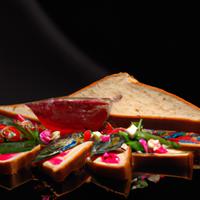
1 serving (50 grams) contains 150 calories, 3.0 grams of protein, 1.5 grams of fat, and 30.0 grams of carbohydrates.

Log this food in SnapCalorie

Nutrition Information
Calories |
714.3 | ||
|---|---|---|---|
% Daily Value* |
|||
| Total Fat | 7.1 g | 9% | |
| Saturated Fat | 1.0 g | 5% | |
| Polyunsaturated Fat | 0 g | ||
| Cholesterol | 0 mg | 0% | |
| Sodium | 952.4 mg | 41% | |
| Total Carbohydrates | 142.9 g | 51% | |
| Dietary Fiber | 4.8 g | 17% | |
| Sugars | 47.6 g | ||
| protein | 14.3 g | 28% | |
| Vitamin D | 0 mcg | 0% | |
| Calcium | 95.2 mg | 7% | |
| Iron | 4.8 mg | 26% | |
| Potassium | 238.1 mg | 5% | |
* Percent Daily Values are based on a 2,000 calorie diet. Your daily values may be higher or lower depending on your calorie needs.
Food Attributes
Source of Calories
About Slice of bread with jelly
A slice of bread with jelly is a simple, versatile snack enjoyed worldwide. Typically, it consists of one slice of bread, which can be whole grain, white, or another variety, spread with fruit jelly made from fruits like strawberries, grapes, or apricots. The bread serves as a source of carbohydrates, fiber, and depending on type, may contain beneficial nutrients like B vitamins. Jelly provides natural sugars and often vitamin C, though it can also contain added sugars depending on the brand or recipe. Originating from the need for quick, sweet spreads, its popularity is rooted in convenience and flavor appeal. Health-wise, whole grain bread offers the most nutritional benefits, contributing fiber and slow-digesting carbs, while the sugar content in jelly may be a concern for those watching their intake. Pairing with protein or fresh fruit can enhance the nutritional balance of this modest yet satisfying snack.



